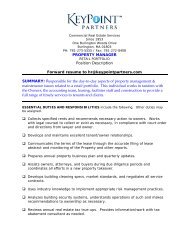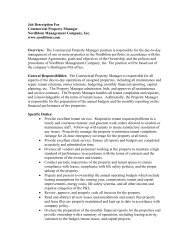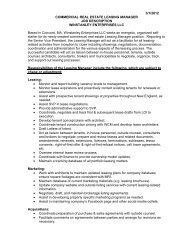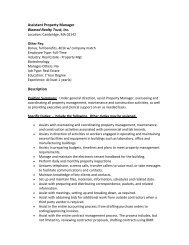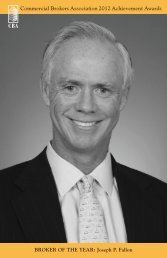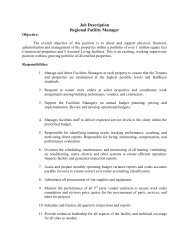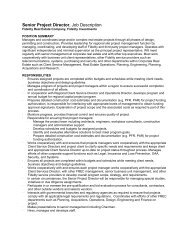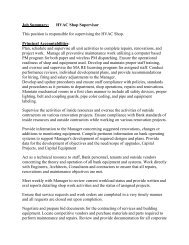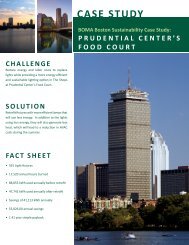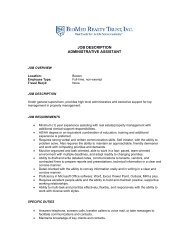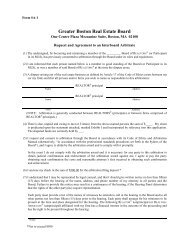The Complete History of GBREB - Greater Boston Real Estate Board
The Complete History of GBREB - Greater Boston Real Estate Board
The Complete History of GBREB - Greater Boston Real Estate Board
You also want an ePaper? Increase the reach of your titles
YUMPU automatically turns print PDFs into web optimized ePapers that Google loves.
<strong>GBREB</strong> HighlightsMarch 22, 1889<strong>The</strong> <strong>Real</strong> <strong>Estate</strong> Exchange and Auction <strong>Board</strong> is incorporated,received its charter from Oliver Ames, Governor <strong>of</strong> theCommonwealth.May 29, 1889<strong>The</strong> first meeting <strong>of</strong> the organization’s incorporators in held atthe Equitable Building in <strong>Boston</strong> and is adjourned due to thelack <strong>of</strong> a quorum.1890<strong>The</strong> Exchange establishes the Arbitration Committee to settlebusiness disputes. This Committee is still recognized as one <strong>of</strong>the most important services provided to members by the <strong>Board</strong>.1903At the request <strong>of</strong> William Lincoln, then president <strong>of</strong> the <strong>Boston</strong>Chamber <strong>of</strong> Commerce, the Exchange takes part in high-levelconferences regarding reforms in <strong>Boston</strong> City Government.May 24, 1914<strong>The</strong> <strong>Boston</strong> Sunday Post says the Exchange is “ the mostinfluential real estate organization in the country,” and notes,“As real estate in <strong>Boston</strong> pays over four-fifths <strong>of</strong> the city’sincome from taxes, it may be fairly said that the interests <strong>of</strong> realestate are paramount and that no commercial or other propertyinterests stand in greater need <strong>of</strong> a strong alliance throughassociation for betterment and defense than the manifold andvaried land interests…<strong>Real</strong> estate deserves and requires a strongand virile alliance for the general welfare.”January 1915<strong>The</strong> Exchange joins the National Association <strong>of</strong> <strong>Real</strong> <strong>Estate</strong><strong>Board</strong>s, now the National Association <strong>of</strong> <strong>Real</strong>tors.1917<strong>The</strong> Exchange in renamed the <strong>Boston</strong> <strong>Real</strong> <strong>Estate</strong> Exchange.<strong>The</strong> World War I Years<strong>The</strong> Exchange raises an ambulance fund. Supports Liberty LoanDrives, and is extremely active in efforts to alleviate the effects<strong>of</strong> the tremendous coal and oil shortages caused by the war.<strong>The</strong> Early 1920s<strong>The</strong> Exchange is active in manners <strong>of</strong> the state’s new zoningcode, statewide height limitations <strong>of</strong> new buildings, tax ratesand tax limitations, street widening, education, and traffic andplanning problems.February 1924After having been in six different locations in 35 years, theexchange moves to Water Street, where it is to remain for morethan 40 years, until moving to 24 School Street.April 1, 1925Charles Lee becomes the organization’s first full time executivesecretary.1932An innovation at the Annual Banquet in the admittance <strong>of</strong>women for the first time, but they are only allowed to sit in thebalcony and are not invited to eat dinner.1934Due to the effects <strong>of</strong> the Great Depression, membership figures<strong>of</strong> the Exchange sink to an all-time low <strong>of</strong> 471, from the 1926peak <strong>of</strong> nearly 700 members. It is not until 1946 that membershiplevels will again reach the 1926 mark.1944<strong>The</strong> Exchange is re-named the <strong>Boston</strong> <strong>Real</strong> <strong>Estate</strong> <strong>Board</strong>,and during this year the <strong>Board</strong> registers a strong protestagainst staggering increases in assessments <strong>of</strong> commercialand apartment property in <strong>Boston</strong>, since the incomes fromapartments have been frozen under rent control for two years.Post World War IIOne <strong>of</strong> the <strong>Board</strong>’s first efforts after the war is to seek removal <strong>of</strong>war-time restrictions on home building.1945Ray H<strong>of</strong>ford is named Executive Officer for both the <strong>Board</strong> and theMassachusetts Association <strong>of</strong> <strong>Real</strong>tors (MAR). In these positions,he unified loose federation <strong>of</strong> rental housing pr<strong>of</strong>essionals intothe Rental Housing Association, one <strong>of</strong> the <strong>Board</strong>’s present fivedivisions., and developed a national reputation as a man <strong>of</strong>vision for the industry.1952Joseph Lund becomes the first <strong>Boston</strong> <strong>Real</strong>tor to serve aspresident <strong>of</strong> the National Association <strong>of</strong> <strong>Real</strong> <strong>Estate</strong> <strong>Board</strong>s. Lundwas the 1948-1949 president <strong>of</strong> the <strong>Boston</strong> <strong>Board</strong>.August 1955<strong>The</strong> <strong>Board</strong>’s Multiple Listing Service(MLS) is established by a small group <strong>of</strong>members.



